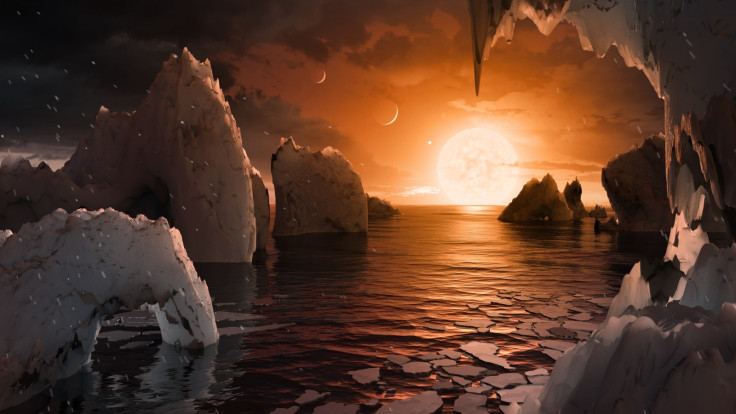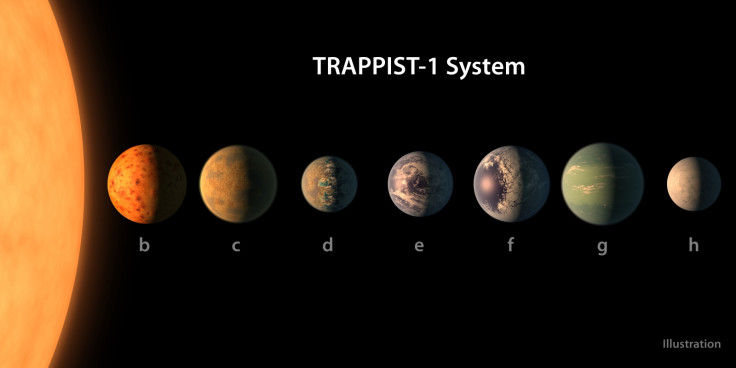Trappist-1 Nasa announcement: We could find alien life within 10 years on newly discovered planets
Scientists find seven potentially habitable exoplanets, three of which are strong contenders for extraterrestrial life.
Seven potentially habitable exoplanets have been discovered in a solar system 40 light years away and, should it exist, we could find evidence of alien life within the next decade. Nasa hosted a press conference on 22 February to reveal the findings of the new study which was a multinational collaboration between top space scientists.
The planets orbit the ultra-cool dwarf star TRAPPIST-1. While three planets had previously been identified within the solar system, further monitoring revealed the presence of four more exoplanets. Through these observations, scientists were able to calculate their masses – showing they are roughly Earth-sized and are probably rocky.
Researchers published their findings in the journal Nature. Study author Michael Gillon said: "This is the first time so many planets of this kind are found around the same star. They form a very compact system – they are very close to each other and very close to the star – reminiscent of the moons around Jupiter. The star is so small and cold that the seven planets are temperate, which means they could have some liquid water hosting life on the surface."
What is even more exciting is that three of the planets sit within the star's habitable zone. This is the region where it would be neither too hot nor too cold for liquid water to be a constant feature. Because of the nature of the star and the solar system, researchers – with current technology – will be able to study the climate and chemical composition of the atmospheres of the seven planets.

Amaury Triaud, another author on the study, explained: "The first stage we are doing is a reconnaissance stage to rule out the planets that have a large hydrogen envelope. This is to make sure they are indeed Earth-like. This will be followed by detailed observations to study the climate and eventually from the chemical formation to try to find out if there is life there. We can expect that within a few years we will know a lot more about these planets and we hope, if there is life there, maybe within a decade."
The Trappist-1 solar system

Unlike our solar system, the planets orbiting Trappist-1 are very close to their star. Indeed, if they were in our system, they would all be found closer to the Sun than Mercury. However, because the star is far cooler than the Sun, it produces far less energy. This means that for liquid water to exist, planets need to be closer to the star.
All of the planets are tidally locked, meaning one side of a planet is always facing the star, while the other is always facing away (so it is either perpetual daytime or night-time). This is not necessarily a bad thing for the potential for alien life, Gillon said. "They would still be able to efficiently transport heat from the day side to the night side. So you have a source. Night is colder but not so cold that it would make the atmosphere collapse and be impossible for habitability. It's not catastrophic for life."
Ultra-cool dwarf stars like Trappist-1 release energy at a far lower rate than stars like our Sun. Scientists estimate it is probably older than half a billion years old. It burns hydrogen so slowly that it will live for around another 100 trillion years.
Which planets are best suited for life?
The three planets the team are most hopeful about in terms of their habitability are Trappis 1e, f and g. "Theoretically you could have liquid water on the seven planets, but three are in the habitable zone – which means with our climate modelling, these planets could have liquid water all over the surface," Gillion said. "These three are more likely to have liquid water because the temperature is fine. It doesn't mean they have liquid water. It will really depend on the atmospheric properties. But we will be able to study them in detail."
Triaud added: "My take is that Trappist 1f is likely the more interesting one. It's about the size of Earth, is a bit cooler but with the right atmosphere and of greenhouse gasses, the temperature should be fine. This is a very speculative question [though]. We don't know how life emerges. If life emerges in an ocean and there is an ocean there I don't see a problem. Water can shield from any radiation. If life is borne elsewhere maybe the conditions are different."
Why is this system our best bet at finding life?
The atmospheres of the planets around Trappist 1 can be studied with existing technology. This means that in the very near future, researchers will be able to find out if any have conditions suitable to hosting life. If we do find conditions similar to what we have on Earth, the team say this would mean we could be 99% confident of the discovery of alien life.
Triaud said: "We've made a crucial step towards finding if there is life out there. I don't think any time before we've had the right planets to find out if there was. Here, if life managed to thrive and releases gasses similar to that what we have on earth, then we will know. Before it was indications, now we have the right target."
Gillion continued: "This is not in a few decades that we can do this. We are doing this now. People will get more and more news about this system in the coming months and years. The story is just beginning."
© Copyright IBTimes 2024. All rights reserved.























